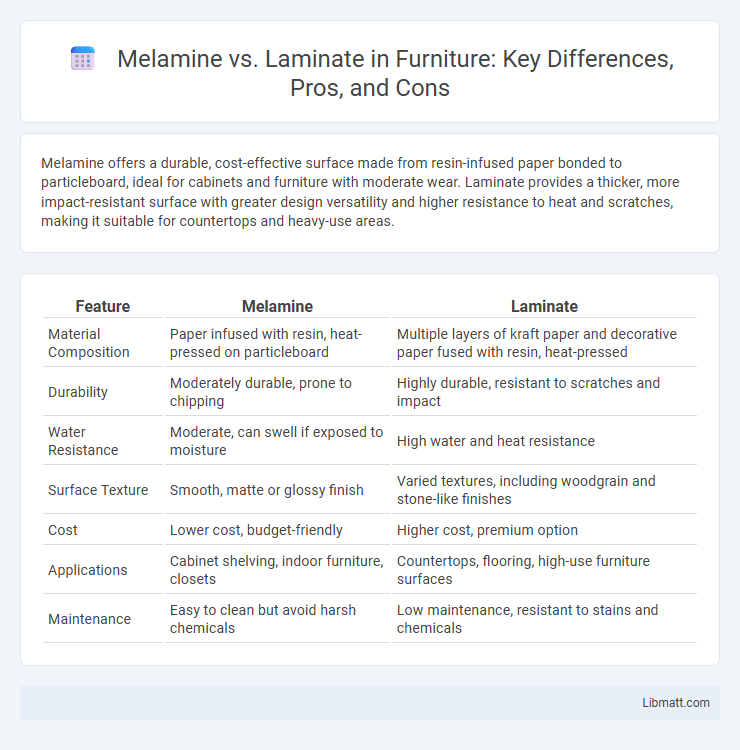Melamine offers a durable, cost-effective surface made from resin-infused paper bonded to particleboard, ideal for cabinets and furniture with moderate wear. Laminate provides a thicker, more impact-resistant surface with greater design versatility and higher resistance to heat and scratches, making it suitable for countertops and heavy-use areas.
Table of Comparison
| Feature | Melamine | Laminate |
|---|---|---|
| Material Composition | Paper infused with resin, heat-pressed on particleboard | Multiple layers of kraft paper and decorative paper fused with resin, heat-pressed |
| Durability | Moderately durable, prone to chipping | Highly durable, resistant to scratches and impact |
| Water Resistance | Moderate, can swell if exposed to moisture | High water and heat resistance |
| Surface Texture | Smooth, matte or glossy finish | Varied textures, including woodgrain and stone-like finishes |
| Cost | Lower cost, budget-friendly | Higher cost, premium option |
| Applications | Cabinet shelving, indoor furniture, closets | Countertops, flooring, high-use furniture surfaces |
| Maintenance | Easy to clean but avoid harsh chemicals | Low maintenance, resistant to stains and chemicals |
Introduction to Melamine and Laminate
Melamine is a durable resin coating applied to particleboard or MDF, offering a smooth, scratch-resistant surface ideal for cabinetry and furniture. Laminate consists of multiple layers of resin-soaked paper fused under heat and pressure, providing a thicker, more robust surface with diverse design options and enhanced durability. Understanding the key differences between melamine and laminate helps you choose the best material for your home's aesthetic and functional needs.
What is Melamine?
Melamine is a durable resin-infused paper used as a surface coating on particleboard or MDF, providing a hard, scratch-resistant finish commonly found in furniture and cabinetry. This synthetic material offers resistance to heat, moisture, and stains, making it a cost-effective option for everyday use. Your choice of melamine allows for easy maintenance while delivering a clean, smooth appearance suitable for various interior applications.
What is Laminate?
Laminate is a synthetic material composed of multiple layers of kraft paper infused with resin, topped with a decorative printed layer and a protective clear coating. It is widely used for furniture surfaces, cabinetry, and countertops due to its durability, moisture resistance, and ease of maintenance. Understanding laminate's structure helps You make informed decisions when choosing materials for high-traffic areas or budget-conscious projects.
Key Differences Between Melamine and Laminate
Melamine is a resin-soaked paper pressed onto particleboard, offering a cost-effective, durable surface ideal for cabinetry and furniture. Laminate consists of multiple resin layers fused under high heat and pressure, providing enhanced durability, heat resistance, and design versatility compared to melamine. While melamine has a thinner coating prone to chipping, laminate's robust composition ensures greater impact resistance and longevity.
Durability: Melamine vs Laminate
Melamine surfaces offer decent durability with resistance to scratches and stains, making them suitable for moderate-use furniture and cabinetry. Laminate provides superior durability, featuring a tougher outer layer that withstands heavy wear, heat, and moisture more effectively than melamine. For high-traffic areas or environments exposed to moisture and heat, laminate is the better choice due to its enhanced resilience and longevity.
Cost Comparison: Which is More Affordable?
Melamine typically offers a more affordable option compared to laminate due to its lower production costs and simpler manufacturing process. Laminate, while generally more expensive, provides enhanced durability and a wider range of design options, which may justify the higher price for long-term use. Your choice depends on balancing budget constraints with desired quality and aesthetic preferences.
Aesthetic Options and Finishes
Melamine offers a wide range of affordable, durable finishes with smooth, matte, and glossy surfaces available in numerous colors and wood grain patterns, making it ideal for budget-friendly, versatile aesthetics. Laminate provides superior realism in textures and finishes, including high-definition wood, stone, and metallic effects, with enhanced resistance to scratches, heat, and moisture, suitable for high-traffic or premium applications. Both materials support customization, but laminate's advanced printing technology and thicker composition deliver more sophisticated visual and tactile appeal.
Maintenance and Cleaning
Melamine surfaces require minimal maintenance and can be easily cleaned with a damp cloth and mild detergent, making them ideal for busy households or offices. Laminate materials offer superior stain resistance and durability, allowing you to use gentle abrasive cleaners for tougher spots without damaging the surface. Your choice between melamine and laminate should consider how much daily cleaning and maintenance you are prepared to undertake for long-lasting appearance.
Best Applications for Melamine and Laminate
Melamine is best suited for cabinetry, shelving, and furniture surfaces in low to moderate traffic areas due to its affordability, ease of cleaning, and resistance to stains and scratches. Laminate excels in high-traffic applications such as countertops, tabletops, and commercial surfaces because of its superior durability, heat resistance, and variety of design finishes. Both materials offer versatile and cost-effective solutions, with melamine favoring budget-conscious, light-use environments and laminate serving demanding, high-wear settings.
Conclusion: Choosing the Right Material
Melamine offers a budget-friendly, easy-to-clean surface ideal for everyday use, while laminate provides greater durability and a wider variety of design options with enhanced resistance to scratches and heat. Your choice depends on the balance between cost, aesthetics, and longevity needed for your project. Assess the specific requirements of your space to select the material that best meets your functionality and style preferences.
melamine vs laminate Infographic

 libmatt.com
libmatt.com